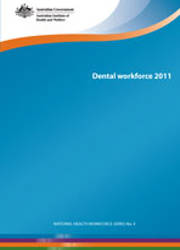Summary
This report presents information on the dental workforce, based on estimates derived from the new National Health Workforce Data Set: dental practitioners 2011, the first for this profession. The data set contains information on the demographic and employment characteristics of dental practitioners (dentists, dental hygienists, dental prosthetists, dental therapists and oral health therapists) registered in Australia in 2011. Data are collected via registration forms and a survey instrument administered by the Australian Health Practitioner Regulation Agency, in conjunction with the annual registration renewal process for dental practitioners.
Size of dental workforce
- In 2011, the total number of dental practitioners registered in Australia was 18,803, of whom 14,179 were dentists.
- Between 2006 and 2011, the number of dentists employed in dentistry increased by 22.4%, from 10,404 to 12,734.
- In 2011 there were also 1,065 dental hygienists, 1,044 dental therapists, 1,088 dental prosthetists and 994 oral health therapists employed in their fields.
Demography
- Just over one-third of employed dentists in 2011 were women (35.6%), an increase from 29.0% in 2006.
- Employed oral health therapists, dental hygienists and dental therapists were substantially more likely to be women (87.9%, 96.1% and 97.1%, respectively).
- Dental prosthetists were much more likely to be men. Women made up 14.2% of the workforce, an increase from 10.0% in 2006.
- Dentists employed in 2011 had an average age of 43.5 years (slightly down from 45.1 years in 2006) and 23% were aged 55 or over. Employed oral health therapists, dental hygienists, dental therapists and dental prosthetists were 32.6, 37.4, 46.3 and 49.3 years old on average, respectively.
Working arrangements
- Dentists worked, on average, 37.4 hours per week in 2011, with 29.9% working part time (less than 35 hours a week). This is a slight decrease from 38.5 hours per week in 2006.
- About four-fifths of employed dentists were working in private practice (81.2% of clinicians and 78.2% of all employed dentists). Two-thirds of dentists in private practice were working in group practices.
- There were 1,426 dentists working as specialists. Orthodontics was the most common specialty (567 dentists). Most specialists worked in private practice in Major cities.
- Major cities had more dentists per capita than other areas in 2011 at 64.1 full-time equivalent (FTE) dentists per 100,000 population. Between 2006 and 2011, the number of dentists increased in all geographical areas.



